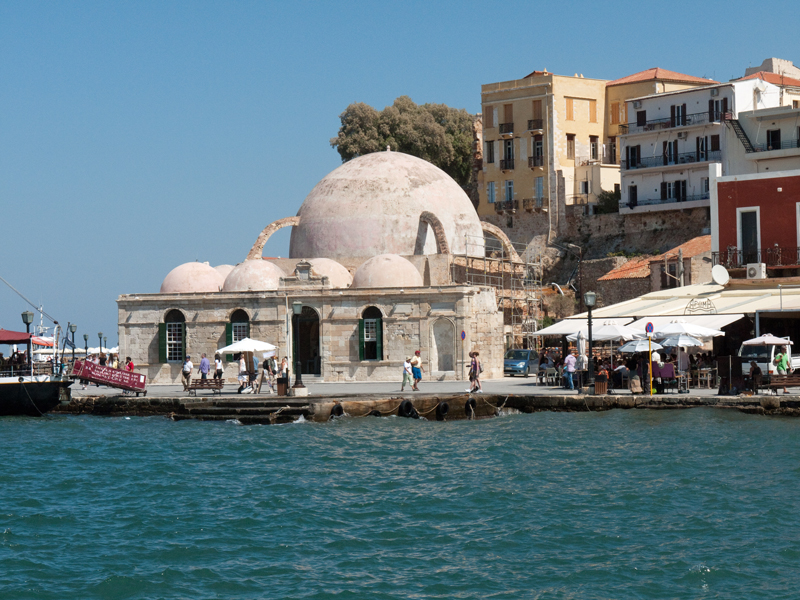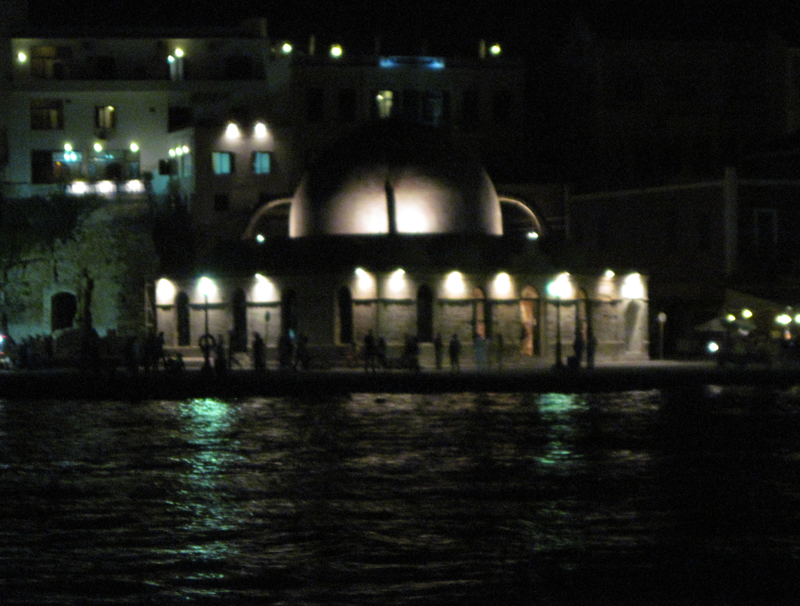-
 ‘Honeymoon’On Saturday morning, while I was visiting the naval museum (and not taking any pictures), Dorothea was again wandering the Old Town. She revisited the top of Zambéliou street and this time got a picture that shows the whole front of this charmingly colorful house.
‘Honeymoon’On Saturday morning, while I was visiting the naval museum (and not taking any pictures), Dorothea was again wandering the Old Town. She revisited the top of Zambéliou street and this time got a picture that shows the whole front of this charmingly colorful house.To leave this gallery...
-
 MihrabThe Mosque of the Janissaries, like all mosques, has a niche called the mihrab located so as to indicate the direction of Mecca, so that worshippers can face in that direction when they pray. Now that Chaniá has no significant Muslim population, the mosque is used for exhibitions rather than prayer.
MihrabThe Mosque of the Janissaries, like all mosques, has a niche called the mihrab located so as to indicate the direction of Mecca, so that worshippers can face in that direction when they pray. Now that Chaniá has no significant Muslim population, the mosque is used for exhibitions rather than prayer.To leave this gallery...
-
 MemorialMost of the historic buildings on the mound of Kastélli were destroyed by the bombing that accompanied the German invasion in 1941. The city of Chaniá has left this site at the bottom of the hill unrepaired to commemorate the buildings, history, and people that were lost at that time.
MemorialMost of the historic buildings on the mound of Kastélli were destroyed by the bombing that accompanied the German invasion in 1941. The city of Chaniá has left this site at the bottom of the hill unrepaired to commemorate the buildings, history, and people that were lost at that time.To leave this gallery...
-
 The MinoaThis replica of an ancient Minoan ship was carefully constructed based on a few paintings that have survived the three and a half millennia since the collapse of that Bronze Age culture. The builders did research on the materials and techniques most likely to have been used back then, and relied as little as practicable on modern substitutes. However, they used plenty of computer simulations in the planning and building.
The MinoaThis replica of an ancient Minoan ship was carefully constructed based on a few paintings that have survived the three and a half millennia since the collapse of that Bronze Age culture. The builders did research on the materials and techniques most likely to have been used back then, and relied as little as practicable on modern substitutes. However, they used plenty of computer simulations in the planning and building.
The ship has been proven seaworthy, and was even sailed and rowed from Crete to Piraeus around the time of the 2004 Olympics. Housed in one of Chaniá’s surviving Venetian arsenali, which were built to shelter war-galleys from the elements, the ship is mounted on a trailer, ready for future launchings.To leave this gallery...
-
 Ship modelThis quarter-size model was built first, using, as far as possible the same materials and techniques that would go into building the ship. The builders hoped to test the validity of their ideas on what the Minoa should be made of and how it should be made—and also, of course, to find out whether their plans and hypotheses were reasonable or crazy.
Ship modelThis quarter-size model was built first, using, as far as possible the same materials and techniques that would go into building the ship. The builders hoped to test the validity of their ideas on what the Minoa should be made of and how it should be made—and also, of course, to find out whether their plans and hypotheses were reasonable or crazy.To leave this gallery...
-
 Another view of the modelThis is a closer look at the model, taken from the stern. You can see in the details how closely it corresponds to the full-sized Minoa. It's hard to tell which is which in a photo, except by comparison with surrounding objects. For instance, Dorothea, who was standing at the far end when I took this picture. It’s her shoulder (in a light green blouse) that you can see at the upper right in the angle between the sail and the gunwale.
Another view of the modelThis is a closer look at the model, taken from the stern. You can see in the details how closely it corresponds to the full-sized Minoa. It's hard to tell which is which in a photo, except by comparison with surrounding objects. For instance, Dorothea, who was standing at the far end when I took this picture. It’s her shoulder (in a light green blouse) that you can see at the upper right in the angle between the sail and the gunwale.To leave this gallery...
-
 Ship's sternThis is the stern of the actual Minoa, not the model. One newly introduced detail is a backwards-looking pelican ornament on the end of the cypress keel. The keel is a single piece, made from the trunk of a cypress tree, that curves from stem to stern and forms both. It defines the ship’s shape in the vertical dimension, while two massive side beams define it in the horizontal dimension by curving around the two sides. They were made from a single cypress trunk that was split with each piece then carved so that its cross-section was round. You can see the starboard side beam in this picture; a steering oar is lashed to it.
Ship's sternThis is the stern of the actual Minoa, not the model. One newly introduced detail is a backwards-looking pelican ornament on the end of the cypress keel. The keel is a single piece, made from the trunk of a cypress tree, that curves from stem to stern and forms both. It defines the ship’s shape in the vertical dimension, while two massive side beams define it in the horizontal dimension by curving around the two sides. They were made from a single cypress trunk that was split with each piece then carved so that its cross-section was round. You can see the starboard side beam in this picture; a steering oar is lashed to it.To leave this gallery...
-
 On deckNot exactly what us landlubbers think of as a deck. The rowers’ seats are on a lower level, and the runway down the middle is for the sailors who work the ropes that control the sail and the steering oars—not, one hopes, for the fat bald guy with the whip so beloved of present-day cartoonists. The port side steering oar shows in the lower left corner, and you can see that it provides plenty of places to fasten ropes. (My nautical vocabulary is too poverty-stricken to provide the proper name for these; I'm thankful that I can even remember port and starboard.)
On deckNot exactly what us landlubbers think of as a deck. The rowers’ seats are on a lower level, and the runway down the middle is for the sailors who work the ropes that control the sail and the steering oars—not, one hopes, for the fat bald guy with the whip so beloved of present-day cartoonists. The port side steering oar shows in the lower left corner, and you can see that it provides plenty of places to fasten ropes. (My nautical vocabulary is too poverty-stricken to provide the proper name for these; I'm thankful that I can even remember port and starboard.)To leave this gallery...
-
 The Inner HarborThe seawall protects the inner harbor from rough water, so that's where most of the boats tie up. At the end you can see two of the three Venetian arsenali that survive there, but the one where we saw the Minoan ship exhibit is out of sight behind the hotel at the right.
The Inner HarborThe seawall protects the inner harbor from rough water, so that's where most of the boats tie up. At the end you can see two of the three Venetian arsenali that survive there, but the one where we saw the Minoan ship exhibit is out of sight behind the hotel at the right.To leave this gallery...
-
 SupervisionMeals eaten outdoors are seldom without four-footed observers. We were careful not to feed them, assuming that Greek restaurateurs would object to that as much as Americans, but one told us he liked the stray dog that showed up regularly. I have to admit that the begging animals we saw were always silent (or at least soft-voiced) and well mannered, and never too persistent. (About the caption title: a supervisor, at least etymologically, is one who looks down on you from above. That's what this kitty was doing as we left, though while we ate she had put in some time mewing vainly at our feet.)
SupervisionMeals eaten outdoors are seldom without four-footed observers. We were careful not to feed them, assuming that Greek restaurateurs would object to that as much as Americans, but one told us he liked the stray dog that showed up regularly. I have to admit that the begging animals we saw were always silent (or at least soft-voiced) and well mannered, and never too persistent. (About the caption title: a supervisor, at least etymologically, is one who looks down on you from above. That's what this kitty was doing as we left, though while we ate she had put in some time mewing vainly at our feet.)To leave this gallery...
-
 In the Archaeological MuseumThe Venetian church of Santo Francesco, converted to a mosque by the Turks, has now become a museum. This is the Roman section: the two mosaic floors in the foreground once belonged to local Roman villas, and the sculpture pieces in the picture date from the same period.
In the Archaeological MuseumThe Venetian church of Santo Francesco, converted to a mosque by the Turks, has now become a museum. This is the Roman section: the two mosaic floors in the foreground once belonged to local Roman villas, and the sculpture pieces in the picture date from the same period.To leave this gallery...
-
 Kalderími restaurantThe little restaurant across the street, photographed from our balcony (between mealtimes). Its name, Kalderími, is probably Turkish in origin and means something like ‘cart track’ or ‘unpaved road’—the owner, who is from the countryside, wanted to evoke rural associations. As you can see, the tables are small and there aren’t very many. Sunday night (like every night we spent in Chaniá), they were all occupied, so we dined in splendid isolation at a table the owner set up for us just around the corner at the top of Ángelou street.
Kalderími restaurantThe little restaurant across the street, photographed from our balcony (between mealtimes). Its name, Kalderími, is probably Turkish in origin and means something like ‘cart track’ or ‘unpaved road’—the owner, who is from the countryside, wanted to evoke rural associations. As you can see, the tables are small and there aren’t very many. Sunday night (like every night we spent in Chaniá), they were all occupied, so we dined in splendid isolation at a table the owner set up for us just around the corner at the top of Ángelou street.To leave this gallery...













